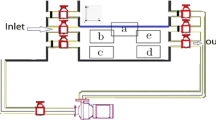Abstract
The efficiency of particle sedimentation in wastewater treatment is seriously affected by particle size distribution and morphology. A laser particle size analyzer is typically to analyze particle size distribution in wastewater. However, using this analyzer for on-line monitoring is difficult. This analyzer cannot measure particle morphology. An on-line digital image analysis (DIA) system was setup in this study to simultaneously measure particle size distribution and morphology in wastewater. The DIA measurement results show that the predominant particle size with an equivalent diameter (ED) was 10–40 μm. The particle size distribution measured by the DIA method similar to that measured with the laser particle size analyzer, indicating that the DIA method precisely measures particle size distribution. In addition, the mean fractal dimension (D f) of a set of particles was measured simultaneously, resulting in a good linear relationship between suspended solids (SS) precipitation efficiencies in samples. Finally, by combining the DIA measurement results with an artificial neural network (ANN), the SS concentrations of sample can be precisely predicted and the SS precipitation efficiencies were also evaluated.
Similar content being viewed by others
References
Choi, D. J., & Park, H. Y. (2001). A hybrid artificial neural network as a software sensor for optimal control of a wastewater treatment process. Water Research, 35, 3959–3967.
Grijspeerdt, K., & Verstraete, W. (1997). Image analysis to estimate the settleability and concentration of activated sludge. Water Research, 31, 1126–1134.
Hill, P. S., Sherwood, C. R., Sternberg, R. W., & Nowell, A. R. M. (1994). In situ measurement of particle settling velocity on the northern California continental shelf. Continental Shelf Research I, 14, 1123–1137.
Lee, D. S., & Park, J. M. (1999). Neural network modeling for on-line estimation of nutrient dynamics in a sequentially operated batch reactor. Journal of Biotechnology, 75, 299–239.
Liao, B. Q., Droppo, I. G., & Liss, S. N. (2006). Effect of solids retention time on structure and characteristics of sludge flocs in sequencing batch reactor. Water Research, 40, 2583–2591.
Mattikalli, N. M. (1997). Soil color modeling for the visible and nearinfrared bands of landsat sensors using laboratory spectral measurement. Remote Sensing of Environment, 59, 14–28.
Metcalf & Eddy Inc. (2003). Wastewater Engineering-treatment, disposal and reuse. (3rd ed.), McGRAW-HILL Inc, ISBN: 0-07-100824-1, 545–555, 730–731.
Schmid, M., Thill, A., Purkhold, U., Walcher, M., Bottero, J. Y., Ginestet, P., et al. (2003). Characterization of activated sludge flocs by confocal laser scanning microscopy and image analysis. Water Research, 37, 2043–2052.
Snidaro, D., Zartarian, F., Jorand, F., Bottero, J.-Y., Block, J.-C., & Manem, J. (1997). Characterization of activated sludge flocs structure. Water Science and Technology, 36, 313–320.
Wilen, B. M., & Balmer, P. (1999). The effect of dissolved oxygen concentration on the structure, size and size distribution of activated flocs. Water Research, 33, 391–400.
Williams, N. D., Walling, D. E., & Leeks, G. J. L. (2007). High temporal resolution in situ measurement of the effective particle size characteristics of fluvial suspended sediments. Water Research, 41, 1081–1093.
Yu, R. F., Chen, H. W., Cheng, W. P., & Chu, M. L. (2006). Measurements of wastewater true color by 4/6 wavelength methods and artificial neural network. Environmental Monitoring and Assessment, 118(1–3), 195–209.
Yu, R. F., Cheng, W. P., & Chu, M. L. (2005). On-line monitoring of wastewater true color using digital image analysis and ANN. Journal of Environmental Engineering, ASCE, 131(1), 71–79.
Yule, B., Roberts, S., Marshall, J. E. A., & Milton, J. A. (1998). Quantitative spore colour measurement using colour image analysis. Organic Geochemistry, 28(3-4), 139–149.
Zhang, Q., & Stanley, S. J. (1999). Real-time water treatment process control with artificial neural network. Journal of Environmental engineering, ASCE, 125(2), 153–160.
Author information
Authors and Affiliations
Corresponding author
Rights and permissions
About this article
Cite this article
Yu, RF., Chen, HW., Cheng, WP. et al. Simultaneously monitoring the particle size distribution, morphology and suspended solids concentration in wastewater applying digital image analysis (DIA). Environ Monit Assess 148, 19–26 (2009). https://doi.org/10.1007/s10661-007-0135-z
Received:
Accepted:
Published:
Issue Date:
DOI: https://doi.org/10.1007/s10661-007-0135-z




